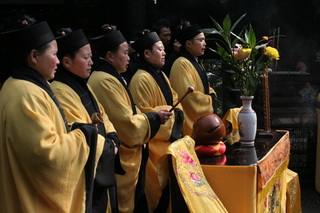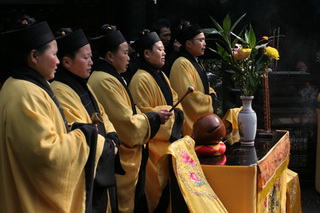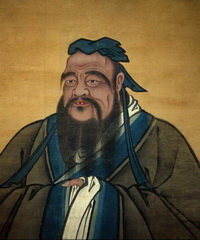


 China Tours
China Tours Tibet Tours
Tibet Tours China Theme Tours
China Theme Tours Off The Beaten Track
Off The Beaten Track Yangtze Cruises
Yangtze Cruises China Trip Planner
China Trip Planner Travel Agents
Travel Agents


We had a wonderful time in Tibet. We have learned a lot about this unique destination because of the wonderful guide Degyi who is so knowledge and always available towards our tours. We stayed at the Shangri-La Hotel Lhasa, and we would never imagine a Tibet travel could be so nice and amazing without the help of Degyi.
Also, thanks a lot to our Tibetan driver Mr.Wongdun for his safe driving and a good sense of service along the way.
We shall return Tibet in the near future!
P.B. and A. A - Europe
Tibet Travel
June 2018 (Private Tibet Journey from Kathmandu)

 China is a multi-religious country. Taoism, Buddhism, Islam, Protestantism and Catholicism have all developed quite harmoniously in this country.
China is a multi-religious country. Taoism, Buddhism, Islam, Protestantism and Catholicism have all developed quite harmoniously in this country.
Buddhism in China
Buddhism is the most important religion in China. It is generally believed that it was spread to China in 67 AD during the Han Dynasty (206 BC-220) from Hotan in Xinjiang to Central China. During its development in China, it has a profound influence on traditional Chinese culture and thoughts, and has become one of the most important religions in China at that time. In general, the development of Buddhism in China can be divided into the following periods. 
Introduction to Buddhism
Buddhism is said to be founded in India in the 6th century B.C. by Siddhatha Gautams, the son of a king and member of the Kshatriya caste near the present borders of India and Nepal. He is also known by the titles Skyamuni (the sage of the Sakya family) and Tathagata (the follower of truth). It is said that at the age of 29 he was confronted with the sights of an old man, a sick man, a corpse, and a wandering ascetic. With eyes opened to aspects of life newly revealed to him, he broke from the material world and became an ascetic. Six years later, he gave up mystic concentration that at last brought him enlightenment under a bodhi tree. He then founded another of mendicants and spent his next 45 years preaching his ideas until his death.
The Four Noble Truths preached by Gautama Buddha are: first sorrow is the universal experience of mankind, and everyone is subjected to the trauma of birth, of sickness, decrepitude, and death; second, the cause of sorrow is desire, especially the desire of the body and the desire for personal fulfillment, and the cycle of birth is perpetuated by the desire for existence; third, the removal of sorrow can only come from the removal of desire, that is to say, happiness can only be achieved if these desires are overcome; and fourth, desire can be systematically abandoned if one follows the Noble Eight-Fold Path.
The Noble Eight-Fold Path includes the following eight tenets:
First, the "Right Knowledge" is to believe that all life is suffering, that suffering is caused by desire for personal gratification, that suffering can be overcome, and that the way to overcome it is to follow the Eight-Fold Path.
Second, the "Right Aspiration" is to become passionately involved with the knowledge of what life's problems basically are.
Third, the "Right Speech" is to avoid lies, idle talk, abuse, slander, and deceit because these things remove a person from the prospect of attaining happiness.
Fourth, the "Right Behavior" is to show kindness and to avoid self-seeking and personal fulfillment in all actions. It also includes five rules: "Do not like;" "do not steal;" "do not lie;" "do not be unchaste;" and "do not drink intoxicants."
Fifth, the "Right Livelihood" is to engage in a suitable activity to earn a living. Buddha considered spiritual progress impossible if one's occupation, such as slave-dealing or prostitution, pulled in the opposite direction.
Sixth, the "Right Effort" is the will to develop virtues and to curb passions.
Seventh, the "Right Mindfulness" is to practice self-examination and to cultivate knowledge of oneself, to overcome the state of semi-alertness, and to become aware of what is happening to oneself.
Eighth, the "Right Absorption" is the way to god through psychological exercises, the mental exercises to penetrate deep into the psyche where the real problems and answers lie, and to achieve a personal experience of what lies hidden within.
By following the Noble Eight-Fold Path, the Buddhist aims to attain "nirvana", a condition beyond the limits of the mind, thoughts, feelings, desire, the will, and a state of bliss and ecstasy.
There are two types of Buddhism in China, Mahayana (Big Raft) Buddhism and Hinayana (Little Raft) Buddhism.
Buddhism Influence in China
The influence of Buddhism on Chinese culture is profound, not only in terms of religion, but also literature, art, and traditional customs, etc. Ancient Chinese architecture, being exquisite and magnificent, especially Buddhist temples, had its configuration originated and imitated from primitive Buddhism of India. The development of sculpture, painting and murals accelerated due to the prosperity of Buddhism in China. Yungang Grottoes located in Datong City of Shanxi province, for example, represents outstanding Chinese Buddhist Grottoes Art during the 5th and 6th century with 51,000 Buddhist statues in 252 grottoes. Chinese literature, such as novels, lyrics and some artistic creations have close interrelationship with translated Buddhist sutra. Many Chinese literati loved reading sutra to get inspired in their imagination and writing skills, which imposed direct influence on the development of Chinese literature. Masterpieces such as A Dream of the Red Chamber (Hong Lou Meng) and Journey to the West (Xi You Ji) are influenced by sutra in terms of structure and writing technique, and are of great literal value. Buddhism also exerted subtle influence on China's traditional customs and social mores. It helped improve people's view on life and the further spreading of filial piety. The principle of "Bad deeds, as well as good, may rebound upon the doer." is deeply rooted in the society, causing people to do good deeds in order to pursue a better afterlife. The advocacy of filial piety in Buddhism makes people go after virtues and pay respect to other people, forming a society of amicability.

Taoism (Daoism)
Taoism is a typically traditional religion in China with a history of more than 18 hundred years since the second century A.D. It advocates the worship of natural objects and ancestors as was practiced since time immemorial and had various factions in the history; later, it evolved into two major factions, namely, Quanzhen and Zhengyi Taoism, and was fairly influential among Han people. It is difficult to calculate the exact number of Taoist believers because there are no formal ceremonies or specific regulations concerning the admission to Taoism. At present, there are more than 15 hundred Taoist temples in China with over 25 hundred male and female Taoists there.
Taoism is based on the teachings of the Tao Te Ching, a short tract written in the 6th century BC in China. Its emphasis on spiritual harmony within the individual complements Confucianism's focus on social duty. Today, there are 20 million Taoists worldwide, most of whom live in China, Taiwan or Southeast Asia. Taoism is also increasingly influential in the West, especially in the field of alternative medicine and in martial arts like Tai Chi.
Taoist Beliefs
The ancient Chinese religion of Taoism is not entirely distinct from Confucianism, for all Chinese religion and philosophy operate within the same ancient worldview. Since earliest times, Chinese thought has been characterized by an awareness of man's close relationship with nature and the universe, a cyclical view of time and the universe, veneration or worship of ancestors, the idea of Heaven, and belief in the divinity of the sovereign. Both Confucianism and Taoism operate within this worldview and incorporate many of its concepts. These two organized belief systems are best viewed as complementary rather than competitive. While Confucianism concerns itself with the social and moral side of life, Taoism focuses on the individual, spiritual life.
The word "Dao" (Tao) translates as "the way". In its broadest sense, Dao is the way the universe functions, the path taken by all natural events. Dao is nature's way, expressed in effortless action. Taoists often use the image of water to illustrate such effortless action. Water always settles to the lowest level and yet can wear away even the hardest of substances.
According to Taoism, the cosmos is a magnitude of harmony and other. It is active, not static. Its state is one of change and variation, perpetually becoming and fading away, contracting and expanding. The Dao guides its function as an ordering principle. Within the Dao, the two elementary powers, Yin and Yang, function by reciprocal action. Yin and Yang are the two polar opposites into which all things can be classified. Thus dark and light, life and death, male and female, good and evil, strong and weak are all manifestations of Yin and Yang.

Confucianism
Confucius is regarded as a great philosopher and a great sage of China. In Chinese, Confucius is called Kong Qiu or Kong Fuzi. It was the Jesuit missionaries of the seventeenth century who came to call him Confucius, and this Latinate name has since become known to the West. Confucianism is a way of life taught by Confucius in the 6th-5th century BC. Sometimes viewed as a philosophy, sometimes as a religion, Confucianism is perhaps best understood as an all-encompassing humanism that neither denies nor slights Heaven. Confucius was said to have been born at Qufu in the State of Lu in what is now Shangdong Province, in about 551 B.C., and he died in 479 B.C. He lived at the end of a troubled age called the "Spring and Autumn Period (770B.C.- 476B.C.)", in which the ducal states of the old Zhou empire were fighting for supremacy, and the resulting chaos led many thinkers to search for fundamental principles of social order and harmony. Confucius wandered about from court to court, attempting to convince rulers of the right way to govern.
Confucianism is a major system of thought in China, developed from the teachings of the Chinese philosopher Confucius and his disciples, and concerned with the principles of good conduct, practical wisdom, and proper social relationships. Confucianism has unfenced the Chinese attitude toward life, set the patterns of living and standards of social value, and provided the background for Chinese political theories and institutions. Confucianism has always fitted naturally into the ancient Chinese pattern of close family ties and absolute rule in which the father governed like an emperor and the emperor was supposed to care for his subjects like a father, which those below obeyed both. This system of belief, through which China was for so long governed, exalts mainly those virtues that fit a static and ideally gentle world, where every family has its place beneath the ruler, and every individual has his place within the family. Confucianism spread from China to Korea, Japan, and Vietnam and has aroused interest among occidental scholars.
Although Confucianism became the official ideology of the Chinese rulers, it has never existed as an established religion with a church and priesthood. Chinese scholars honored Confucius as a great teacher and sage, but did not worship him as a personal god. Nor did Confucius himself ever claim divinity. The principles of Confucianism are contained in nine ancient Chinese works handed down by Confucius and his followers, who lived in an age of great philosophic activity. These teachings can be divided into two groups: The Five Classics and The Four Books.
The Five Classics, which originated before the time of Confucius, consist of the following works: the Yijing(Classic of Changes), Shujing(Classic of History), Shijing (Classic of Poetry), Liji (Classic of Rites), and Chun Qiu (Spring and Autumn Annals).
Classic of Changes is a manual of divination probably compiled before the 11th century B.C. Its supplementary philosophical portion, contained in a series of appendices, may have been written by Confucius and his disciples. Classic of History is a collection of ancient historical documents, and Classic of Poetry, an anthology of ancient poems. Classic of Rites deals with the principles of conduct, including the rules to be observed at public and private ceremonies. Spring and Autumn Annals, the only work reputedly compiled by Confucius himself, is a chronicle of major historical events in feudal China from the 8th century B.C. to the time of Confucius' death early in the 5th century B.C.
The Four Books, compilations of the sayings of Confucius and Mencius and of commentaries by followers on their teachings, are Lunyun (The Analects of Confucius), a collection of maxims of Confucius that form the basis of his moral and political philosophy; Daxue(The Great Learning) and Zhongyong (The Doctrine of the Mean), containing some of Confucius philosophical utterances arranged systematically with comments and expositions by his disciples, and Mengzi ( The Book of Mencius) containing the teachings of one of Confucius' great followers.
The keynote of Confucian ethics is ren, variously translated as "benevolence", "love", "goodness", "humanity" , and "human heartedness". Ren is a supreme virtue representing human qualities at their best. In personal relation, construed as those between man and man, ren is manifested in zhong, or faithfulness to oneself and others, and shu, decency reciprocity or altruism, best expressed in the Confucian golden rule: "Do not do to others what you do not want done to yourself". Other important Confucian virtues include righteousness (yi), propriety (li), wisdom (zhi), trustworthiness or integrity, and filial piety. One who possesses all these virtues becomes a "junzi", a perfect gentleman. Politically, Confucius advocated a paternalistic government in which the sovereign is benevolent and honorable and the subjects are respectful and obedient. The ruler should cultivate himself and become morally perfect so that he can set a good example to his people. In education Confucius upheld the theory that "in education, there is no class distinction".
Christianity in China
Christianity was introduced to China in early 19th century and widely spread after 1840s. In 1950, the church called on its believers to shake off the vestige of foreign imperialist influence and uphold patriotism in order to achieve self-administration, self-supporting and self-propagation, which are the cardinal principle of Chinese Christianity. At present, there are about ten million Christian believers, 18 thousand priests and 12 churches or religious sites in China.
Christianity is a religion centered in Jesus Christ as the supreme revelation of God and as Lord of His followers, and based upon His teaching. Christianity comprises three principal divisions: The Roman Catholic Church, the various Protestant churches organized as a result of the Reformation, and the Holy Orthodox Catholic Apostolic Eastern Church (Eastern Orthodox Church), which includes the various organizations adhering to the Byzantine rites. Although these different Christian churches together embrace a wide diversity of beliefs and practices, they embody in some way the elements pertaining to Jesus: a story, a doctrine, and a life. The story, known as the Gospel, comprises the events associated with Jesus' life and ministry. The doctrine is that Jesus is in some sense a unique person, the Son of God, through whom man can live in the right relation to God. The life is that the Christian pursues in imitation of Jesus' life, in accordance with Christ's teachings and dominated by love for God and one's fellow men.
Among the major organizational divisions of Christianity, the Eastern Orthodox Church and the Roman Catholic Church agree in most points of doctrine and worship, but the various communions of the former do not accept the supremacy of the Church of Rome and its bishop, the pope. Accordingly, although those communions accept many of the doctrines enunciated by the Roman Catholic Church since their separation from it in 1054 A.D., they do not consider such doctrines essential to Christianity.
Roman Catholicism and Protestantism differ most basically on the issue of the authority that much determines doctrine and life. Catholicism considers the church as the final authority under Christ and teaches that the authority of Scripture is derived from that of the Church. In direct opposition to this, Protestantism has maintained historically that Scripture is the final authority under Christ and that the authority of the Church is secondary. The Roman Catholic view of ecclesiastical authority is the basis not only for the doctrine of the primacy of the Church of Rome and the infallibility of the pope in his official pronouncements, but also for such distinctively Catholic teachings as the perpetual virginity and sinlessness of Mary, the mediation of Mary and the saints in prayer, and the transformation of the sacramental bread and wine into the literal body and blood of Christ. The Protestant doctrine of the supreme authority of Scripture, on the other hand, has permitted the development of divergent and even contradictory interpretations of Scripture, each claiming to be the true interpretations of Scripture. The major Protestant denominational divisions are Lutheranism, Presbyterianism, the Reformed churches, Congregationalism, Methodism, and the Baptist churches.
Christianity appeared very early in China. Small groups of "Nestorian" Christians, who spread about Europe, the Near East, and Asia, arrived in Western China before the seventh century, established small communities, and moved into Eastern China, but they were largely absorbed into the Chinese society.
The Christian faith planted itself more firmly in China in the late sixteenth century when the Ming emperors allowed Jesuit priest, let by Matteo Ricci, to build churches and to located in Beijing and other cities. Catholicism began to develop after the Opium War in 1840, and by 1949 there were about 3 million Catholics in China.
Protestantism was first brought to China in 1807 by the British Baptist Robert Morrison, thought it initially had very little influence. Missionaries poured into China in the 1840s and particularly after the Opium War. In 1949, there were 700,000 Chinese Protestants.
In July 1954, a national Protestant congress was held at which the Chinese National Christian Three-self Patriotic Movement Committee was founded. In July 1957, the Chinese Patriotic Catholic Association was founded to manage the church independent of the Vatican.
There are now more than 3.6 million Catholics in China. Over 1,000 Catholic churches have been newly established or restored since the end of the "cultural revolution" in 1976. A magazine called The Catholic Church in China came out in 1981 with a circulation of more than 400,000 copies. There are now 5,500,000 protestants in China, an eight fold increase over the 1949 figure of 700,000.
In the past four decades, Chinese Christians have established friendly relations with many Christian organization and personages abroad and have attended several world conferences on Christianity.
Catholicism
Catholicism was first introduced to China in the seventh century and widely spread across the country after the Opium War in 1840. At present, Chinese Catholic Church boasts one hundred parishes, some five million believers, nearly five thousand cathedrals and places for religious activities and twelve theological seminaries. Over the past two decades, the Catholic Church in China have cultivated more than 15 hundred young bishops who are able to hold consecration and among them over one hundred have been sent abroad for further study. In addition, three thousands young girls have been crowned the nunhood after their admission and two hundred nuns have decided to dedicate all their lives to the church. Every year, more than 50 thousand clerics from the Chinese Catholic Church preside over baptism and the church prints over three million copies of Bible.
Islam in China
Islam is a monotheistic religion based on revelations received by the Prophet Muhammad in the 7th century, which were later recorded in the Qur'an (Koran), Islam's sacred text. The faith spread rapidly and today Islam is the second largest religion in the world. The Arabic word islam means "submission," reflecting the religion's central tenet of submitting to the will of God. Islamic practices are defined by the Five Pillars of Islam: faith, prayer, fasting, pilgrimage and alms.
Islam was officially introduced into China in 651 A.D. by Arabian envoys to Emperor Gao Zong of the Tang Dynasty. Through out the Tang(618-907 A.D.) and Song(960-1279 A.D) Dynasties, many Arab and Persian merchants of Islamic faith came over land to northern China by way of the "Silk Road" and by sea to Quanzhou and other ports in southeast China. Some mosques were built in China by these merchants.
Moslems pray five times daily: at dawn, at noon, in the afternoon, in the evening, and at nightfall. A crier, or muezzin, announces the prayer time. The worshipers ceremonially wash their faces, hands, and feet in the bath area immediately before praying. The prayers generally consist of reciting passages from the Koran and other phrases of praise to God.
The Islamic festivals observed in China are, mainly, those of Lesser Bairam, Korban Bairam, and Mohammed's Birthday. Lesser Bairam, held on the first day of the tenth month of the Islamic calendar immediately after the month of fasting, is a highly festive day with sumptuous meals because no Islamite is allowed to eat between dawn and sunset during the previous month of fasting called Ramdam. Korban Bairam has its origins in ancient Arabic mythology as day of sacrifice. The Proghet Abraham was told by Allah on the tenth day of the twelfth month of the Islamic calendar to kill his son Ishmael. He was going to execute this order when he was told by Allah to kill a sheep instead. Thus, every year on this day Moslems offer a sacrifice of sheep. Mohammed's Birthday is also his death anniversary, for he is believed to have died on the twelfth day of the third month in the Islamic calendar.
Chinese Moslems live mostly in the areas of the Xinjiang Uygur Autonomous Region, Ningxia Hui Autonomous Region and four autonomous prefectures and thirteen autonomous counties in other parts of China.


 0086-28-85711328
0086-28-85711328 0086-28-85546015
0086-28-85546015
